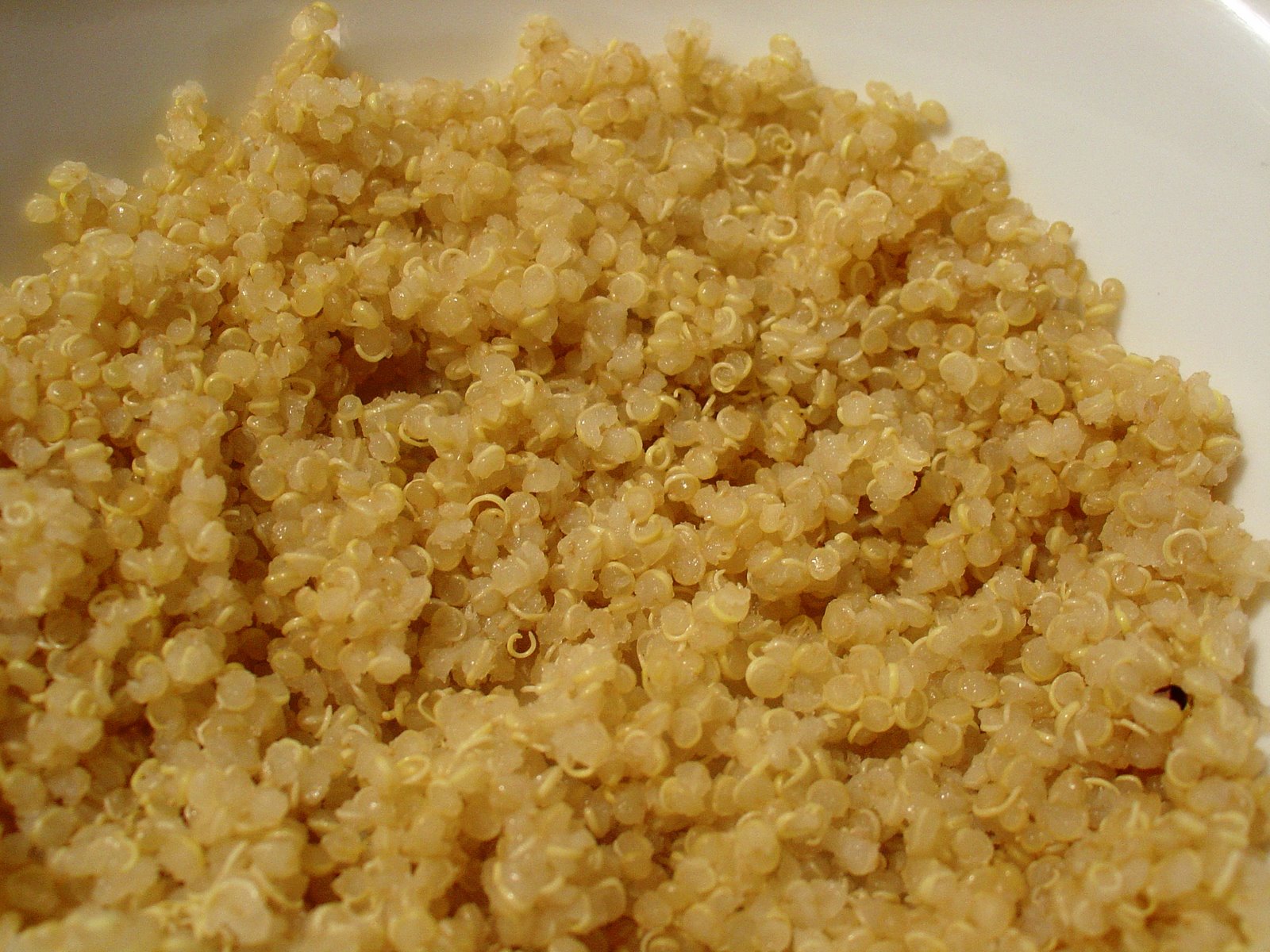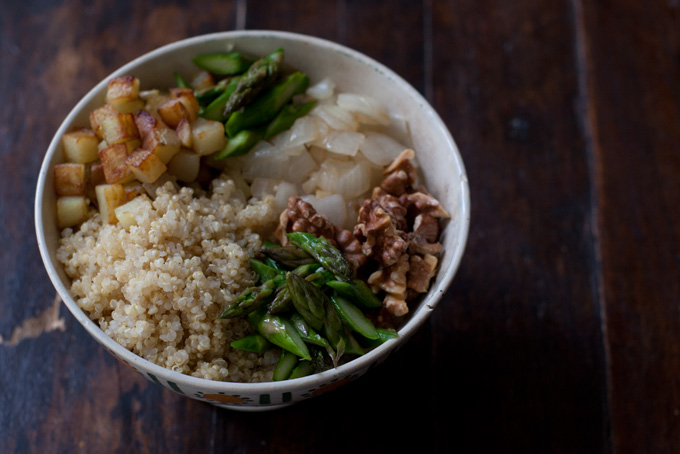- First of all, it can be pronounced one of two ways: kin-oh-wah, or keen-wah.
- It looks like a grain, and many cooks use it in recipes the same way you'd use rice or some other type of grain, but actually quinoa are the seeds of a leafy-green plant called goosefoot. Other plants in this family include chard, spinach, and beets.
One variety of quinoa plant. The seeds are in the bunchy clusters.
(Photo from CCBol Group)
- There are 120 species of quinoa, so the seeds can be any one of several colors, ranging from ivory to pink, brown, and black.
Here's another variety of quinoa, this one with red seeds
(Photo from CCBol Group)
- Quinoa has been cultivated in South American countries such as Peru, Chile, and Bolivia for thousands of years. It was a sacred food for the Incas, who used to live in the Andes in South America. For them, quinoa was the "mother seed."
- Quinoa was so central to the Incan culture that the Spanish conquistadors made it against the law for the Incans to grow quinoa, and anyone caught growing it could face punishments as extreme as death.
- So the cultivation of quinoa nearly disappeared from the planet. It might have disappeared completely but for a few secret patches high in the mountains where the Incas grew small amounts of quinoa. Some native peoples in North America were growing it too, but very few and far between.
- In the 1980s, two Americans who were students of a Bolivian spiritual leader began cultivating it in Boulder, Colorado. Since then, more and more people have sought it out as a tasty, wholesome food.
- The conditions under which quinoa thrives do make it seem like it is a magical plant: it prefers 10,000 foot-plus altitudes, drought, and sandy, alkaline soil. It does well in the hot sun and it also carries on in the face of below-freezing temperatures. One pound of seeds, or four cups, can yield an acre of plants, enough to feed ten people for a year. The United Nations has declared it a "super crop."

The pink quinoa in this picture looks pretty fantastic -- but it's real, and you can eat it!
(Photo from the Benson Agriculture & Food Institute)
- Vegetarians love it because it 12 - 18% of each grain is protein -- and that protein is complete. No need to pair it with beans or some other protein source.
- It's low in gluten so some people with celiac disease or gluten allergies can tolerate quinoa.
- Quinoa has lots of magnesium, which means it could be helpful in combating migraines, or getting those annoying muscle twitches to stop, or reducing hypertension or other cardiovascular woes.
- As with any food, though, don't expect it to cure something all by itself. Eat it in moderation, and make sure your diet has a wide variety of fruits and vegetables and other good stuff.

Light and dark-colored quinoa seeds
(Photo from Organic Jar)
- To prepare quinoa, even if you buy it commercially packaged, it's a good idea to put the seeds in a fine strainer and give them a good, thorough rinse with cold water. The seeds have a soapy, bitter residue, and some extra rinsing will help get rid of that soapiness. The best way to know if you've rinsed enough is to taste some of the seeds. If they still taste bitter, rinse some more.
- If you want to cook it like rice, the ratio to follow is one part quinoa, two parts liquid. You could use water or broth or water with soy sauce or whatever you like. Bring it to a boil, then reduce the heat and simmer about 15 minutes. When the seeds have been cooked long enough, they will be translucent and the germ will have partially detached, looking like a curly tail. That little tail will stay crunchy though the body of the seed will soften.

Here's a close-up of the cooked quinoa. I had to shrink the image so it would fit, but hopefully you can see the little curly tails.
(Photo from The Cooker, who also has more nice photos and recipes)
- You can also dry-roast it, the way you might toast sliced almonds, which will bring out more of its nutty flavor.
- Quinoa can also be ground into flour to make tortillas or pasta.
- You can also use it in other flour-based items like cookies or muffins. But on its own it doesn't rise, so you'd have to combine it with at least some wheat flour.
- It can also be fermented to make a type of beer called chicha. Most people make chicha from corn, but apparently quinoa chicha also is available.

Cooked quinoa in a bowl with asparagus, potatoes, walnuts, and onions. Looks a lot like rice, doesn't it?
(Photo and recipe by Heidi, posted at 101 Cookbooks)
- There are tons of recipes out there that use quinoa, but here are a few good-looking ones:
- Quinoa-Stuffed Peppers (scroll down about halfway)
- Quinoa and Butternut Squash Gratin
- Artichoke Heart and Quinoa Salad
- Toasted Quinoa Pilaf
- Italian-Style Quinoa-Stuffed Sole
- Multigrain Bread with Quinoa
- If you want to grow your own, you can sprout the seeds sort of like alfalfa sprouts. Put about 1/3 cup of seeds in a jar of water and let them soak for 4 hours or so, then drain them and rinse them. Do this twice a day for 2 to 4 days. The seeds will sprout, and when those sprouts are about 1 inch long, put them near a window so the sun can help them develop a bright green color.
- And finally, quinoa is also a really good word to know for Scrabble.
Sources
The Columbia Encyclopedia, Sixth Edition, quinoa
Encarta World English Dictionary, North American edition, quinoa
Whole Foods, Quinoa
Vegetarians in Paradise, Quinoa, Soul Food of the Andes
Chet Day's Health & Beyond, Quinoa from the Andes by Karen Railey
Nicole Spiridakis, NPR, Quinoa: A Sacred, Super Crop
No comments:
Post a Comment
If you're a spammer, there's no point posting a comment. It will automatically get filtered out or deleted. Comments from real people, however, are always very welcome!